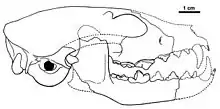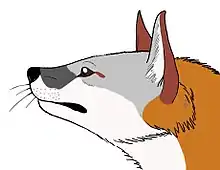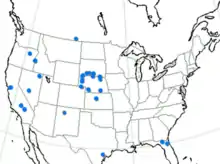Leptocyon
The genus Leptocyon (Greek: leptos slender + cyon dog) includes 11 species and was the first canine. They were small and weighed around 2 kilograms (4.4 lb). They first appeared in North America around 34 million years ago in the Oligocene at the same time as the Borophaginae with whom they share features, indicating that these were two sister groups. Borophaginae skull and dentition were designed for a powerful killing bite compared with the Leptocyon which were designed for snatching small, fast-moving prey. The species L. delicatus is the smallest canid to have existed. At the close of their genus 9 million years ago one Leptocyon lineage resembled the modern fox.[1]
| Leptocyon | |
|---|---|
 | |
| Drawing of the holotype skull of Leptocyon gregorii | |
 | |
| Scientific classification | |
| Kingdom: | Animalia |
| Phylum: | Chordata |
| Class: | Mammalia |
| Order: | Carnivora |
| Family: | Canidae |
| Subfamily: | Caninae |
| Genus: | †Leptocyon Matthew, 1918 |
| Species | |
| |
 | |
| Fossil range of Leptocyon species | |
| Synonyms | |
|
Neocynodesmus Macdonald 1963 | |
Leptocyon were small-bodied, fox-like animals with a long, narrow jaw and delicate teeth. They were probably omnivorous, feeding on small animals and fruit in a diet that remained relatively unchanged during the Miocene.[2]
References
- Wang & Tedford 2008, p. 53.
- Wang & Tedford 2008, p. 51.
Bibliography
- Wang, Xiaoming; Tedford, Richard H. (2008). Dogs:Their Fossil Relatives and Evolutionary History. Columbia University Press, New York. ISBN 978-0-231-13529-0.CS1 maint: ref=harv (link)